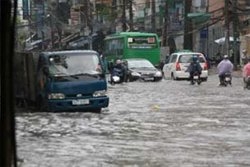A study by the World Bank (WB) said Vietnam would need to spend around USD850 million annually adapting to climate change for the next 40 years.
 |
| A street in HCMC submerged under water after rain |
Tran Thi Thanh Phuong, senior environmental specialist of the WB in Vietnam, said at a conference for the national strategy on climate change until 2030, vision to 2050 that global warming is threatening all economies in the world and Vietnam is among the most affected.
Phuong said the WB’s latest study calculated that Vietnam would need US$850 million annual spending for the four economic fields that are most vulnerable to climate change, to be safe from the extreme weather, rising sea levels and other disasters.
The agricultural sector needs USD160 million, infrastructure for flood prevention requires USD540 million, aquaculture needs USD130 million and seaport construction requires USD12 million to mitigate the negative impacts.
“Within the next ten years Vietnam has to adapt to climate change in some areas such as agriculture, traffic, forestry, urban planning, aquaculture resources protection, energy development and waste management,” Phuong said.
According to the national strategy on climate change to 2030, vision to 2050 that was released last Friday by the Ministry of Natural Resources and Environment, by 2100 the annual average temperature may increase by 3 to 5 degrees Celsius and sea levels may rise by one meter.
Meanwhile, the magnitude and frequency of extreme climate change events such as storms will surge. Tropical cyclones, floods, droughts, heat waves or cold fronts may be unpredictably altered.
The strategy said if the country does not apply measures for consolidating dykes and sluices immediately, rising sea levels will likely submerge a total area of 30,945 square kilometres, which is the equivalent to 9.3% of the ground surface of the country. These worsening figures could see the Mekong Delta, Dong Nai River basin, Ho Chi Minh City, Red River basin and other coastal regions completely submerged under water.
Tran Hong Ha, deputy minister of natural resources and environment, told the Daily the most obvious indicators of climate change occurring in Vietnam are higher flood tides, more severe floods, droughts and salinity intrusion.
Thus, a series of urgent action plans for all ministries, economic sectors, provinces and cities between now and 2015 have to implemented immediately.
Vietnam has 52 projects approved in accordance with the clean development mechanism for global carbon emission reductions.
Other urgent tasks will also focus on developing green technology, encouraging the use of renewable and clean energy such as wind, solar, developing flood maps with sea level rise scenarios, as well as reviewing irrigation and water resources management and planning for the Mekong Delta, Red River and areas most vulnerable to climate change.
To help finance this national strategy, Ha said Vietnam has already received many commitments from other countries such as Japan, France and Canada to help with finance and technology to cope with climate change and reduce the risk of disasters.
“The Danish Government has just supported Vietnam with USD40 million to deploy the national strategy on climate change,” he said.

Leave your comment on this story